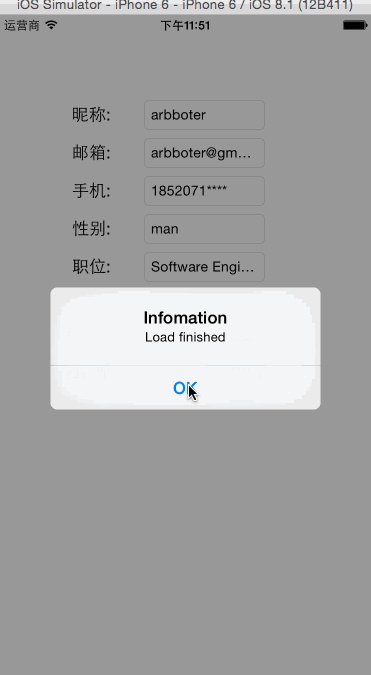概要
数据持久化分为不同的方式,本章主要简示了数据归档(一般而说的序列化)和写XML的文本文件方式。其中XML文本方式主要使用NSArray或者NSDictionary的writeToFile方法,而数据归档使用了NSKeyedArchiver/NSKeyedUnarchiver等实现数据的归档(序列化)。
结果展示
程序展示
数据化文件
注意新版本的IOS模拟器的目录和以前的目录不在同一个地方,其中plist文件是XML文件,可打开直接查看,而archi是归档的二进制文件。
流程概要
1.新建工程,拖拉界面,完成程序除归档外的操作,具体操作:略
2.对于XML存储,将需要存储的数据放到字典或者数组中,然后调用WriteToFile把数据保存到文件,使用类方法initWithContentsOfFile读取存储的数据即可
3.数据归档化相对而言较复杂点,需要新建一个数据类,该类需要实现了NSCoding协议,然后实现编码和解码两个方法。
4.在需要数据存储的地方把需要的数据放到步骤3中的数据类的对象中,然后结合使用NSMutableData和NSKeyedArchiver实现数据归档。
5.略
主要代码
数据类
h文件
//
// Staff.h
// DataXMLArchiver
//
// Created by God Lin on 14/12/9.
// Copyright (c) 2014年 arbboter. All rights reserved.
//
#import <Foundation/Foundation.h>
@interface Staff : NSObject <NSCoding>
{
NSString* _nickName;
NSString* _email;
NSString* _phone;
NSString* _sex;
NSString* _position;
}
@property (nonatomic, retain) NSString* _nickName;
@property (nonatomic, retain) NSString* _email;
@property (nonatomic, retain) NSString* _phone;
@property (nonatomic, retain) NSString* _sex;
@property (nonatomic, retain) NSString* _position;
@end
m文件
//
// Staff.m
// DataXMLArchiver
//
// Created by God Lin on 14/12/9.
// Copyright (c) 2014年 arbboter. All rights reserved.
//
#import "Staff.h"
@implementation Staff
@synthesize _nickName;
@synthesize _email;
@synthesize _phone;
@synthesize _sex;
@synthesize _position;
#pragma NSCoding 实现序列化(归档)
- (void)encodeWithCoder:(NSCoder *)aCoder
{
[aCoder encodeObject:self._nickName forKey:@"nickName"];
[aCoder encodeObject:self._email forKey:@"email"];
[aCoder encodeObject:self._phone forKey:@"phone"];
[aCoder encodeObject:self._sex forKey:@"sex"];
[aCoder encodeObject:self._position forKey:@"position"];
}
- (id)initWithCoder:(NSCoder *)aDecoder
{
self._nickName = [aDecoder decodeObjectForKey:@"nickName"];
self._email = [aDecoder decodeObjectForKey:@"email"];
self._phone = [aDecoder decodeObjectForKey:@"phone"];
self._sex = [aDecoder decodeObjectForKey:@"sex"];
self._position = [aDecoder decodeObjectForKey:@"position"];
return self;
}
@end
程序主体代码
h文件
//
// ViewController.h
// DataXMLArchiver
//
// Created by God Lin on 14/12/9.
// Copyright (c) 2014年 arbboter. All rights reserved.
//
#import <UIKit/UIKit.h>
@interface ViewController : UIViewController
{
IBOutlet UITextField* _textNickName;
IBOutlet UITextField* _textEmail;
IBOutlet UITextField* _textPhone;
IBOutlet UITextField* _textSex;
IBOutlet UITextField* _textPosition;
}
@property (nonatomic, retain) UITextField* _textNickName;
@property (nonatomic, retain)UITextField* _textEmail;
@property (nonatomic, retain)UITextField* _textPhone;
@property (nonatomic, retain)UITextField* _textSex;
@property (nonatomic, retain)UITextField* _textPosition;
-(IBAction)onHideKeyboard:(id)sender;
-(IBAction)onXmlSave:(id)sender;
-(IBAction)onXmlLoad:(id)sender;
-(IBAction)onArchiverSave:(id)sender;
-(IBAction)onArchiverLoad:(id)sender;
@end
m文件
//
// ViewController.m
// DataXMLArchiver
//
// Created by God Lin on 14/12/9.
// Copyright (c) 2014年 arbboter. All rights reserved.
//
#import "ViewController.h"
#import "Staff.h"
@interface ViewController ()
@end
@implementation ViewController
@synthesize _textNickName;
@synthesize _textEmail;
@synthesize _textPhone;
@synthesize _textSex;
@synthesize _textPosition;
-(IBAction)onHideKeyboard:(id)sender
{
[sender resignFirstResponder];
}
-(NSString*)getDocumentDir
{
// 获取保存的文件名
NSArray* arrayPath = NSSearchPathForDirectoriesInDomains(NSDocumentDirectory, NSUserDomainMask, YES);
return [arrayPath objectAtIndex:0];
}
-(void)textClear
{
self._textNickName.text = @"";
self._textEmail.text = @"";
self._textPhone.text = @"";
self._textSex.text = @"";
self._textPosition.text = @"";
}
// XML文本保存数据,可使用数组字典等保存数据
-(IBAction)onXmlSave:(id)sender
{
// 保存数据到字典
NSMutableDictionary* dict = [[NSMutableDictionary alloc] init];
[dict setObject:self._textNickName.text forKey:@"nickName"];
[dict setObject:self._textEmail.text forKey:@"email"];
[dict setObject:self._textPhone.text forKey:@"phone"];
[dict setObject:self._textSex.text forKey:@"sex"];
[dict setObject:self._textPosition.text forKey:@"position"];
NSString* pathFile = [self getDocumentDir];
pathFile = [pathFile stringByAppendingPathComponent:@"staff.plist"];
// 数据写入文件
[dict writeToFile:pathFile atomically:YES];
UIAlertView* alert = [[UIAlertView alloc] initWithTitle:@"Infomation" message:@"Save finished" delegate:nil cancelButtonTitle:@"OK" otherButtonTitles:nil];
[alert show];
// 使用ARC,自己不需要管理内存
//[alert release];
[self textClear];
}
-(IBAction)onXmlLoad:(id)sender
{
// 获取保存的文件名
NSString* pathFile = [self getDocumentDir];
pathFile = [pathFile stringByAppendingPathComponent:@"staff.plist"];
NSDictionary* dict = [[NSDictionary alloc] initWithContentsOfFile:pathFile];
self._textNickName.text = [dict objectForKey:@"nickName"];
self._textEmail.text = [dict objectForKey:@"email"];
self._textPhone.text = [dict objectForKey:@"phone"];
self._textSex.text = [dict objectForKey:@"sex"];
self._textPosition.text = [dict objectForKey:@"position"];
UIAlertView* alert = [[UIAlertView alloc] initWithTitle:@"Infomation" message:@"Load finished" delegate:nil cancelButtonTitle:@"OK" otherButtonTitles:nil];
[alert show];
}
// 归档化数据
-(IBAction)onArchiverSave:(id)sender
{
Staff* staff = [[Staff alloc] init];
staff._nickName = self._textNickName.text;
staff._email = self._textEmail.text;
staff._phone = self._textPhone.text;
staff._sex = self._textSex.text;
staff._position = self._textPosition.text;
// 新建二进制内存(读写)
NSMutableData* data = [[NSMutableData alloc] init];
// 设置二进制内存数据内容(读写)
NSKeyedArchiver* archiver = [[NSKeyedArchiver alloc] initForWritingWithMutableData:data];
[archiver encodeObject:staff forKey:@"staff"];
[archiver finishEncoding];
// 获取保存的文件名
NSString* pathFile = [self getDocumentDir];
pathFile = [pathFile stringByAppendingPathComponent:@"staff.archi"];
// 保存数据(归档)
[data writeToFile:pathFile atomically:YES];
UIAlertView* alert = [[UIAlertView alloc] initWithTitle:@"Infomation" message:@"Archive finished" delegate:nil cancelButtonTitle:@"OK" otherButtonTitles:nil];
[alert show];
[self textClear];
}
-(IBAction)onArchiverLoad:(id)sender
{
// 获取保存的文件名
NSString* pathFile = [self getDocumentDir];
pathFile = [pathFile stringByAppendingPathComponent:@"staff.archi"];
// 读取归档文件到内存(只读)
NSData* data = [NSData dataWithContentsOfFile:pathFile];
// 解码内存数据(只读)
NSKeyedUnarchiver* unarchiver = [[NSKeyedUnarchiver alloc] initForReadingWithData:data];
Staff* staff = [unarchiver decodeObjectForKey:@"staff"];
[unarchiver finishDecoding];
self._textNickName.text = staff._nickName;
self._textEmail.text = staff._email;
self._textPhone.text = staff._phone;
self._textSex.text = staff._sex;
self._textPosition.text = staff._position;
UIAlertView* alert = [[UIAlertView alloc] initWithTitle:@"Infomation" message:@"Load from Archiver finished" delegate:nil cancelButtonTitle:@"OK" otherButtonTitles:nil];
[alert show];
}
- (void)viewDidLoad
{
[super viewDidLoad];
// Do any additional setup after loading the view, typically from a nib.
}
- (void)didReceiveMemoryWarning {
[super didReceiveMemoryWarning];
// Dispose of any resources that can be recreated.
}
@end























 236
236











 被折叠的 条评论
为什么被折叠?
被折叠的 条评论
为什么被折叠?








